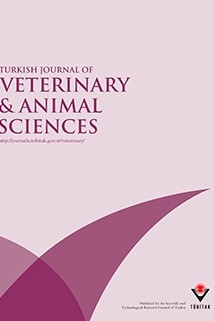
Turkish Journal of Veterinary and Animal Sciences
Yazarlar: Haq NAWAZ, Muhammad YAQOOB, Muhammad ABDULLAH
Konular:-
Anahtar Kelimeler:Tallow,Nili-Ravi buffalo,Nutrient intake,Milk composition,Energetic efficiency,Income/cost ratio
Özet: In order to determine the feeding value of tallow for lactating Nili-Ravi buffaloes, 4 buffaloes were fed 0%, 2%, 4%, or 6% tallow in a 4 X 4 Latin square experiment. The intakes of dry matter (DM), organic matter (OM), crude protein (CP), acid detergent fiber (ADF), and neutral detergent fiber (NDF) decreased (P < 0.01), but the intakes of ether extract (EE) (P < 0.01) and digestible energy (DE) (P < 0.05) increased with increasing levels of tallow in the diets. Intake of net energy for lactation (NEL) did not differ (P < 0.01) with varying levels of supplemental tallow. Daily milk yield increased (P < 0.01) from 11.00 to 13.2 kg/day. Production of 4% fat corrected milk (FCM), solid corrected milk (SCM), and energy corrected milk (ECM) increased quadratically (P < 0.05) with the increasing level of tallow in the diets. Milk fat content and total milk fat increased linearly (P < 0.01) and quadratically (P < 0.05), respectively, as the level of tallow in the diet increased. There was no difference in protein and lactose content due to feeding tallow. Total solid content increased quadratically (P < 0.05) from 16.45% to 17.67% but solid not fat (SNF) percentages did not vary with varying levels of tallow. The gross energy (GE) of the milk increased from 1096 to 1160 Kcal/kg (P < 0.01) with increasing levels of tallow in the diets. Energetic efficiency of milk production improved in a quadratic (P < 0.05) manner with 2%, 4%, and 6% tallow, with the highest being 47.6% with 4% supplemental tallow. The proportion of C8:0 to C16:1 fatty acids (FA) decreased from 53.66% to 35.52%, whereas the concentration of C18:0 to C20:0 increased (44.93% to 62.84%) in the milk fat of buffaloes fed diets containing different levels of tallow. Gains in body weight (BW) were higher (P < 0.05) in buffaloes fed diets containing supplemental tallow as compared to those fed the control diet. This study suggests that tallow up to 6% of diet DM is a suitable fat supplement as an economical energy source for lactating buffaloes.